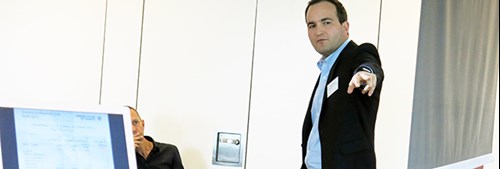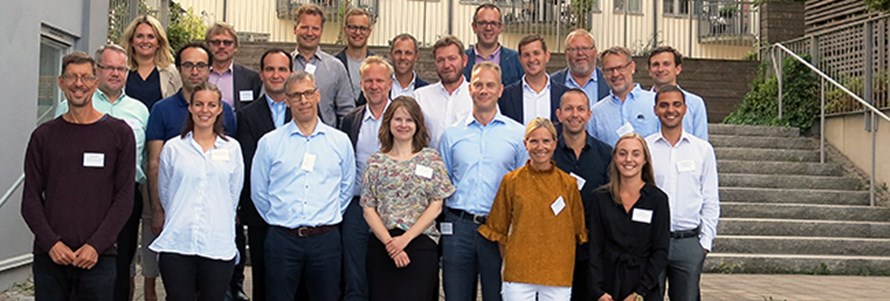After a warm welcome by co-founder Alexander Ljungqvist, the conference was kicked off by Dario Pozzoli (CBS) who presented the paper “Coordination of Hours within the Firm.” Pozzoli uses observational and quasi-experimental data to examine the impact on wage differentials and labor supply elasticities of coordination among workers with heterogeneous preferences for working hours. As workers increasingly perform tasks jointly, employers derive productivity benefits from standardizing working hours, but at the cost of imposing utility costs on workers who may prefer more customized hours and so demand higher wages. Examining this trade-off with employee-employer data from private companies in Denmark, the authors show that when one group of workers are affected by an exogenous shock to their working hour preferences (in the form of a tax reform), there are substantial spillover effects on other workers unaffected by the shock. Pozzoli argues that ignoring these distortions leads to estimates of labor supply elasticity that have a significant downward bias, a fundamental result highlighted by discussant Tore Ellingsen (SSE).

Many interesting papers were presented at the NICE conference. The discussions that followed were lively.
The second paper presented at the conference was “Multi-Product Firms, Import Competition and the Evolution of Firm-product Technical Efficiencies”, by Frederic Warzynski (Aarhus University) and co-authors. The paper examines the effect of an increase in import competition on technical efficiencies at multi-product firms in Belgium. Using detailed quarterly firm-product data from 1997 to 2007, the authors estimate firm-product quarterly technical efficiencies using a novel multi-product production function. To identify technical efficiencies, the authors utilized two econometric methods: OLS and an instrumental variables approach. Warzynski and co-authors find that a 0.01 increase in import share leads to a 1.05% gain in technical efficiency. As such, a central contribution of the paper, as pointed out by discussant Karen Helene Ulltveit-Moe (University of Oslo), is the paper’s focus on the effect of import competition on productivity, in contrast to the typical focus on labor market outcomes.
Before lunch, Esther Ann Bøler (Imperial College London) presented the paper “Technology-Skill Complementarity in a Globalized World.” Bøler adds to previous research on skill-biased technological change by focusing on firm-level productivity and firms’ demand for skills. Combining structural estimation with causal evidence from a Norwegian change in R&D policy which affected the correlation between productivity and R&D, the author finds that within-firm skill-biased productivity growth can account for the majority of the observed increase in skill premia for workers. In turn, Bøler proposed that policies promoting R&D may not only boost aggregate productivity, but its impact on skill-augmenting productivity may also increase firms’ demand for skilled labor and thus wage inequality.

Ramin P. Baghai (SSE) presented his paper “Bankruptcy, Team-specific Human Capital, and Productivity: Evidence from U.S. Inventors.”
After lunch, Ramin P. Baghai (SSE) presented his paper “Bankruptcy, Team-specific Human Capital, and Productivity: Evidence from U.S. Inventors.” Seeking to understand if labor markets can preserve team-specific human capital, Baghai and co-authors study the impact of corporate bankruptcies on the productivity and careers of inventors in the United States. Exploiting bankruptcy filings as a shock to teams, the authors use a fixed-effects model at the inventor-year-level to estimate the effect of bankruptcy on the inventors’ subsequent productivity. The authors find that inventors who rely more on co-authorship before bankruptcy suffered more (in the form of a lower quantity and quality of subsequent patents) after bankruptcy than inventors who relied less on co-authorship. Inventors relying more on co-authorships were found to be more likely to exit the labor market, post-bankruptcy. However, they also had a higher likelihood of moving to another firm together, post-bankruptcy. The papers main take-away is that the labor market to some extent manages to preserve productive team constellations.
Otto Toivanen, Aalto School of Business, presented a study of an R&D policy reform, with some similarities to Bøler’s paper. Toivanen and his co-author perform a theoretical and ex-ante counterfactual analysis of the 2013-14 Finnish R&D tax credit regime, focusing on its effects on firms’ incentives to innovate. To do so, the authors model the behavior of firms and Finland’s subsidy granting agency under five scenarios including R&D subsidies, tax credits, and combinations thereof. Toivanen summarized their result as follows: an R&D tax credit scheme has a positive impact on the intensive but not the extensive margin of innovation, compared to no government support. However, compared to subsidies, the impact is negligible in all dimensions. Finally, the authors find specific choices of nonlinearities in tax credit schemes can both improve social welfare and induce considerable public costs with little effect on R&D as incentives for projects above a threshold are effectively removed.

In the front Otto Toivanen, Aalto School of Business, listening to a presentation.
The last presenter of the first conference day was Alexander Ljungqvist (Stockholm School of Economics) who together with fellow conference participant Konrad Raff (Norwegian School of Economics) presented “Busy Directors: Strategic Interaction and Monitoring Synergies.” Studying directors who sit on multiple boards at the same time, the authors investigate whether the positive spillovers from a greater network and know-how outweigh the lack of time these directors have for each board. Ljungqvist and Raff ask, when is it harmful to shareholders to appoint busy directors and when is it beneficial? The answer depends on two dimensions, firm synergies (i.e., transferability of expertise from one firm to another) and strategic interaction (i.e., the reaction of directors in spillover firms to busy directors’ monitoring activity). Exploiting brokerage closures as exogenous shocks to firms’ information environments and hence busy directors’ available time for their other board commitments, the authors show that busy directors reduce monitoring at their other boards if there are negative synergies and vice versa in the case of positive synergies. On average, directors at spillover firms match busy directors’ levels of monitoring activity, suggesting that directors view their monitoring efforts as strategic complements. The upshot is that busy directors can be either harmful or beneficial, depending on the nature of the monitoring synergies between the firms and how directors interact with each other on boards.

Cédric Schneider commenting on a paper by Tuomas Takalo and Otto Toivanen: "Estimating the Potential and Pitfalls of an Innovation Policy Reform: A Counterfactual Analysis of the Finnish R&D Tax Credit Scheme".
Andreas Moxnes (University of Oslo) kicked off the second day of the conference. In the paper “The Origins of Firm Heterogeneity: A Production Network Approach,” Moxnes studies how buyer-supplier connections are related to firm size. Even within narrowly defined industries, there are substantial differences in firm size, and a significant share of this dispersion remains unexplained. The aim of the paper is thus to explore how downstream and upstream factors may explain the firm-size distribution. Using Belgian data on production-network input-output relationships, the paper estimates a regression to explain firm sales through three factors: buyer-specific, seller-specific, and final demand. The empirical analysis shows that downstream factors explain the majority of firm size heterogeneity in Belgium. Moxnes proposed a theoretical model in which firms buy inputs from upstream suppliers and sell to downstream buyers and final demand, to explain his estimates of the input-output structure of the economy. Finally, he presented a counterfactual analysis suggesting that the production network accounts for more than half of the firm size heterogeneity in Belgium.
Per Olsson (ESMT Berlin) presented a paper about payoffs to shareholders and CEOs of real aggressive behavior and aggressive reporting behavior. Research that posits a connection between real aggressive decisions -- such as aggressive investment decisions -- and aggressive reporting decisions -- such as reporting quality -- often suggests the decisions are intended to meet earnings targets. Olsson presented evidence that real aggressive behavior and reporting aggressiveness are positively correlated, that more aggressive real behaviors by management are associated with lower shareholder and CEO payoffs, and that more aggressive reporting is associated with higher shareholder and CEO payoffs. Even though aggressive reporting is associated with a greater likelihood of accounting restatements, the adverse returns reaction to restatements does not eliminate the long-run positive returns of the pre-restatement period or the period for which results are restated. Reporting choices may, Olsson further explained, be used to mitigate the effects of real activities.

Kaveh Majlesi commenting on paper and presentation by Ramin Baghai.
The final presenter of the conference was Lars Persson (IFN). Persson and co-authors Pehr-Johan Norbäck and Roger Svensson’s paper “Verifying High Quality: Entry for Sale” develops a model of when and how entrepreneurs sell their inventions. The model refers to the “lemons” problem, suggesting that when buyers have less information than sellers, only low-quality products will be sold since buyers’ willingness-to-pay reflects the average quality of the product in the market. Persson showed that in the process of an entrepreneur seeking to sell an invention of good quality to an incumbent firm, she can first enter the product market to verify the true quality, and then do a “late sale” to get the full price. Entrepreneurs with low-quality inventions, on the other hand, will not be able to generate the amount of revenue needed to cover the cost of product-market entry and will thus sell without first entering the product market. Incumbents realize this incentive and discount their willingness-to-pay accordingly. Persson further showed empirical evidence of entry as a verification device using data on a sample of Swedish patents from 1998. The Possibility to enter the product market as a means of signaling can thus mitigate the problem of asymmetric information, which spurs high-quality inventions.
Text: Marcos Demetry, Hedda Nielsen, and Charlotta Olofsson

